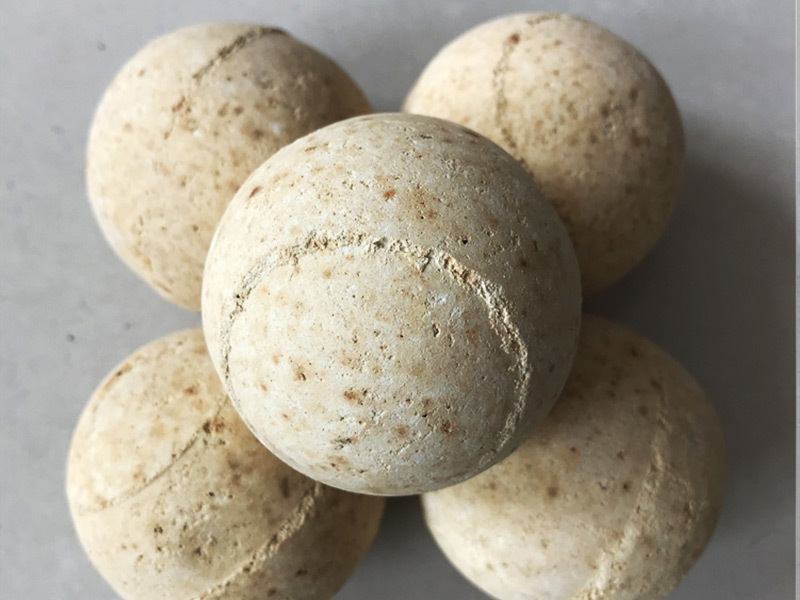Low creep refractory balls
Classification:
Product Introduction
Low creep refractory ball is a kind of refractory product, creep refers to the slow plastic deformation of the material over time under the action of high temperature and certain pressure. Low creep refractory balls are spherical refractories with relatively low creep rate in high temperature environments.
Low creep refractory ball composition and raw materials
It is mainly made from raw materials such as high-purity alumina (Al₂O₃). High-purity alumina has good refractory properties, and its content is generally at a high level, for example, the alumina content in some low-creep refractory balls can reach more than 90%. In addition, it may contain small amounts of additives, such as titanium dioxide (TiO₂), yttrium oxide (Y₂O₃), etc. These additives can improve the microstructure of the material and inhibit the growth of grains at high temperatures, thereby reducing the creep rate.
Low creep refractory ball performance characteristics
Good stability at high temperature: It can maintain stable shape and structure in high temperature environment. For example, in some high-temperature industrial kilns, the temperature may reach 1600 - 1800°C, and the low creep refractory balls can withstand such high temperatures for a long time without obvious deformation, ensuring the normal operation of the kiln and the effective handling of internal materials.
High mechanical strength: It has sufficient compressive strength to withstand the weight of the material in the kiln as well as its own stacked weight. Its strength can also be maintained at a certain level at high temperature, so as to avoid crushing due to insufficient strength during use, which will affect the normal operation of the kiln.
Good chemical stability: strong resistance to erosion of many chemicals. In some industrial processes, various corrosive gases or slags may be present in the kiln, and low-creep refractory balls can resist the attack of these chemicals and reduce the impact of chemical corrosion on their performance.
Low creep refractory ball production process
Raw material mixing: First of all, the main raw materials such as alumina and additives are accurately mixed according to a certain proportion, and this process needs to ensure the uniformity of the raw materials, and a mixer is generally used to fully stir.
Molding: The mixed raw materials are made into spherical shapes using a suitable molding method. The common molding method is the rolling ball method, which uses special equipment to make the raw material gradually form a ball during the rolling process, and the dimensional accuracy of the ball should be controlled to meet different use requirements.
Sintering: The formed spheres are placed in a high-temperature kiln for sintering. The sintering temperature is generally around 1700 - 1800 °C, and the material can be densified through sintering, and its strength and fire resistance can be improved. In the sintering process, parameters such as heating rate, holding time and cooling rate should be strictly controlled to obtain low-creep refractory balls with good performance.
Low creep refractory pellet applications
Iron and steel industry: used as a heat storage body in blast furnace hot blast furnaces. The function of the hot blast furnace is to heat the air and send it to the blast furnace, and the low creep refractory ball can efficiently store and release heat, and ensure the heat storage performance and structural stability of the hot blast furnace in the long-term high-temperature working environment.
Ceramic industry: used for the support and heat storage of ceramic kilns. When firing ceramic products, the temperature in the kiln is high, and the low creep refractory ball can provide stable support for ceramic products, and also contribute to the uniform distribution of heat and improve the quality of ceramic products.
Chemical industry: In some high-temperature reactors, such as cracking furnaces in the petrochemical industry, it is used as a filler material for heat exchange and support of reactive substances to ensure that the reaction process is carried out in a high-temperature and stable environment.
The low creep rate of low creep refractory balls is essential to ensure stability and reliability in high-temperature applications, helping to extend the life of the material and protect the furnace
| Projects | Physical and chemical indicators | |
| RQAD-70 | ||
| (Al2O3)/% | ≥ | 70 |
| (Fe2O3)/% | ≤ | 1.8 |
| Bulk density/(g/cm3) | ≥ | 2.60 |
| Apparent porosity/% | ≤ | 24 |
| Normal temperature withstand voltage value/kN | ≥ | 15 |
| Load softening start temperature/°C (100N/ball) | ≥ | 1550 |
| Thermal shock stability (1100°C, water cooling)/time | ≥ | 15 |
| Creep rate/% (100N/ball, 1400°C, 50h) | ≤ | 1.0 |
Key words:
Low creep refractory balls
Refractory balls
Related Products
Product inquiry


